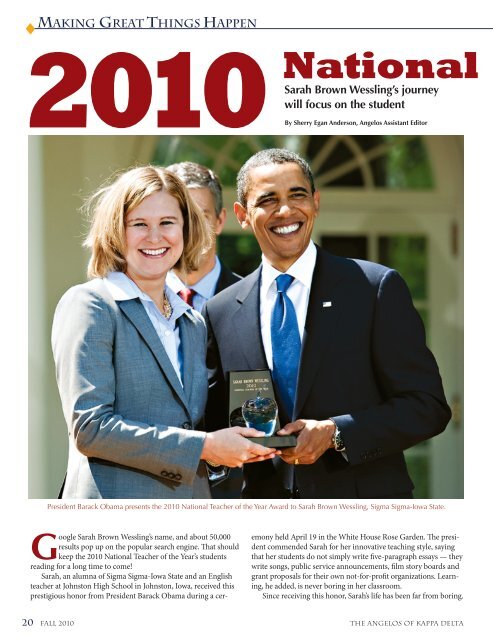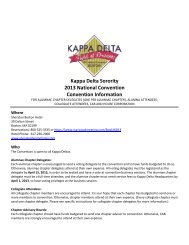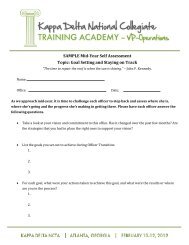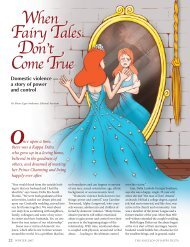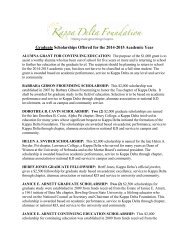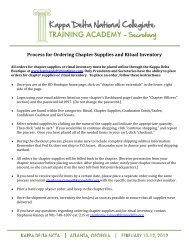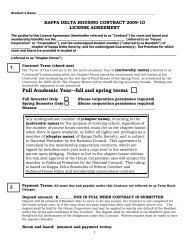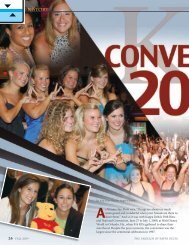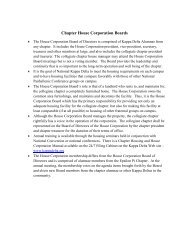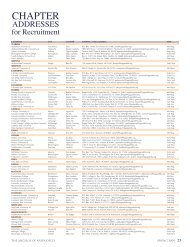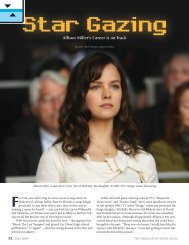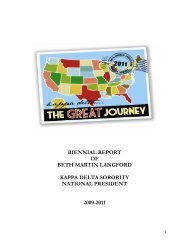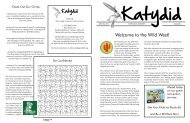2010 National Teacher of the Year - Kappa Delta
2010 National Teacher of the Year - Kappa Delta
2010 National Teacher of the Year - Kappa Delta
- No tags were found...
Create successful ePaper yourself
Turn your PDF publications into a flip-book with our unique Google optimized e-Paper software.
Feature Making Great things happen<strong>2010</strong><strong>National</strong>Sarah Brown Wessling’s journeywill focus on <strong>the</strong> studentBy Sherry Egan Anderson, Angelos Assistant EditorPresident Barack Obama presents <strong>the</strong> <strong>2010</strong> <strong>National</strong> <strong>Teacher</strong> <strong>of</strong> <strong>the</strong> <strong>Year</strong> Award to Sarah Brown Wessling, Sigma Sigma-Iowa State.Google Sarah Brown Wessling’s name, and about 50,000results pop up on <strong>the</strong> popular search engine. That shouldkeep <strong>the</strong> <strong>2010</strong> <strong>National</strong> <strong>Teacher</strong> <strong>of</strong> <strong>the</strong> <strong>Year</strong>’s studentsreading for a long time to come!Sarah, an alumna <strong>of</strong> Sigma Sigma-Iowa State and an Englishteacher at Johnston High School in Johnston, Iowa, received thisprestigious honor from President Barack Obama during a ceremonyheld April 19 in <strong>the</strong> White House Rose Garden. The presidentcommended Sarah for her innovative teaching style, sayingthat her students do not simply write five-paragraph essays — <strong>the</strong>ywrite songs, public service announcements, film story boards andgrant proposals for <strong>the</strong>ir own not-for-pr<strong>of</strong>it organizations. Learning,he added, is never boring in her classroom.Since receiving this honor, Sarah’s life has been far from boring.20 fall <strong>2010</strong> THE ANGELOS OF KAPPA DELTA
Making Great things happen<strong>Teacher</strong> <strong>of</strong> <strong>the</strong> <strong>Year</strong>“I am learning so much, meeting amazingpeople and doing new things every day,”Sarah says. With three young children,she has found <strong>the</strong> hardest part is balancingher new responsibilities with caringfor her family. Sarah says she’s grateful for“a great support group <strong>of</strong> friends and familywho help.”Sarah’s trip to <strong>the</strong> White House begana yearlong journey as <strong>the</strong> nation’s topteacher. Her summer was a whirlwind <strong>of</strong>trips, media interviews and a flood <strong>of</strong> e-mails and Facebook messages that she hasbeen determined to personally answer. In<strong>the</strong> coming year, she will travel extensivelyto more than 150 engagements where shewill serve as a keynote speaker, workshopfacilitator or award presenter. To do this,Sarah has taken a sabbatical from teaching.Already, she was out <strong>of</strong> <strong>the</strong> classroom inspring <strong>2010</strong> fulfilling her duties as Iowa’s<strong>Teacher</strong> <strong>of</strong> <strong>the</strong> <strong>Year</strong>. In addition, Sarahserves as president <strong>of</strong> <strong>the</strong> Iowa Council <strong>of</strong><strong>Teacher</strong>s <strong>of</strong> English.“I miss [teaching] horribly!” Sarah says.“It’s one <strong>of</strong> those situations where I want tohave both: The classroom is where I am inmy element, but this opportunity is amazing.I am so passionate about what I do andabout my message, so this is a great opportunityto talk about what I love.”To say that what Sarah loves is “teaching”may oversimplify <strong>the</strong> passion thatdrives her and <strong>the</strong> goals that she is determinedto reach. Speaking on behalf <strong>of</strong> <strong>the</strong>o<strong>the</strong>r <strong>Teacher</strong> <strong>of</strong> <strong>the</strong> <strong>Year</strong> finalists, Sarahwrote on The White House Blog: “Ourdream for our students is <strong>the</strong> same dreamwe have for our own children, to be recognizedfor <strong>the</strong>ir strengths, to learn from<strong>the</strong>ir weaknesses and to be seen as persons<strong>of</strong> infinite potential.”When Sarah travels in <strong>the</strong> comingyear, <strong>the</strong> message she will share is this:“Students need worthy learning experiences.<strong>Teacher</strong>s must give <strong>the</strong>m learningassignments worth doing. . . . The mostimportant aspect is to keep students at <strong>the</strong>center <strong>of</strong> our focus.”With this in mind, Sarah will promotean open model <strong>of</strong> learning. For example,Sarah places her desk in <strong>the</strong> back <strong>of</strong> <strong>the</strong>classroom, and this placement, she says, “isan outward sign <strong>of</strong> an implicit philosophy,that teaching must be learner-centered.The desk in <strong>the</strong> back <strong>of</strong> <strong>the</strong> room displaceshierarchies, creates an environmentwhere a teacher becomes a lead learner,Sigma Sigma-Iowa State alumna SarahBrown Wessling is <strong>the</strong> <strong>2010</strong> <strong>National</strong><strong>Teacher</strong> <strong>of</strong> <strong>the</strong> <strong>Year</strong>.and evolves into a web <strong>of</strong> interdependencewhere <strong>the</strong> classroom walls becomeboundless. When we embrace this openmodel <strong>of</strong> learning, <strong>the</strong> consumers <strong>of</strong> ourcurriculum will become designers <strong>of</strong> <strong>the</strong>irown learning.”In <strong>the</strong> past, learning was <strong>of</strong>ten basedon memorization <strong>of</strong> facts. “Informationtechnology has flattened out that hierarchy,”Sarah says. “Our students want to becreators. They don’t want to passively learnmaterial and <strong>the</strong>n regurgitate it.”Sarah organizes units <strong>of</strong> study aroundcentral questions. With this focus on inquiry,she wants students to develop a style<strong>of</strong> learning that will last a lifetime. Whenher students read <strong>the</strong> classic “To Kill aMockingbird,” Sarah does not ask <strong>the</strong>mstandardized questions. Instead, she’ll ask<strong>the</strong> students to reflect on “courage,” andthis complex concept will be at <strong>the</strong> center<strong>of</strong> discussion. Sarah says, “The purpose isfor <strong>the</strong> students to become au<strong>the</strong>ntic readers,writers and thinkers in <strong>the</strong> pursuit <strong>of</strong>an idea.”To aid her students in this process,Sarah utilizes individual discussions andfeedback, <strong>of</strong>ten incorporating an audiocomponent. As she reviews a student’sdraft for a major assignment, she’ll recordher questions, comments and suggestionsand <strong>the</strong>n e-mail <strong>the</strong> podcast to <strong>the</strong> studentto use her feedback in completing <strong>the</strong> finalcopy <strong>of</strong> <strong>the</strong> paper. Or, she’ll spend classtime meeting individually with studentsand recording <strong>the</strong>ir conferences — <strong>the</strong>questions that arose, concerns that wereaddressed and positive comments thatwere made. Each student can <strong>the</strong>n referback to his podcast <strong>of</strong> <strong>the</strong> conference.“I give a lot <strong>of</strong> feedback,” Sarah says,“And it’s that feedback that I feel is reallyimportant in helping <strong>the</strong>m engage inlearning. Sometimes <strong>the</strong> amount <strong>of</strong> timeit takes to give au<strong>the</strong>ntic answers can beoverwhelming, but to remove that fromwhat I do as a teacher could never work.”This personal attention has helpedSarah to get to know her students and <strong>the</strong>irlearning styles. Each learner is a story, shesays, and <strong>the</strong>se stories compel, sustain andteach her. Until she returns to <strong>the</strong> classroomnext year, she will take <strong>the</strong>se storieswith her wherever she goes as a reminderthat teaching must focus on <strong>the</strong> student.Sarah says <strong>the</strong> greatest challenge shehas faced as a classroom teacher hasbeen to meet <strong>the</strong> needs <strong>of</strong> every studentbecause <strong>the</strong>y are so varied. She adds,“<strong>Teacher</strong>s cannot do this in isolation. Weneed to see o<strong>the</strong>r teachers and parents asimportant resources.”When Sarah stood at <strong>the</strong> White Housepodium, she issued this challenge: “Infront <strong>of</strong> us all is <strong>the</strong> collective responsibilityto create hope and opportunity forevery child in this country.”To view <strong>the</strong> video <strong>of</strong> <strong>the</strong> <strong>National</strong> <strong>Teacher</strong><strong>of</strong> <strong>the</strong> <strong>Year</strong> presentation at <strong>the</strong> WhiteHouse, visit http://www.whitehouse.gov/photos-and-video/video/president-obamahonors-<strong>2010</strong>-national-teacher-year.THE ANGELOS OF KAPPA DELTA fall <strong>2010</strong> 21


